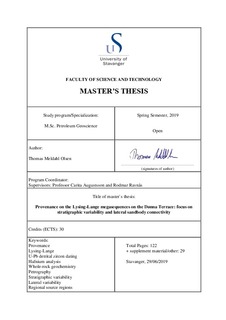| dc.description.abstract | The Cenomanian to Coniacian-Turonian Lange-Lysing megasequences are located on the Dønna Terrace in the Norwegian Sea. Provenance study using traditional provenance methods such as petrography, whole-rock geochemistry, and single grain U-Pb and hafnium isotope analysis, combined with stratigraphy were used to test the validity of correlation within the megasequences. Low to a high degree of weathering and recycling, a different tectonic setting between a continental island arc and passive continental margin combined with element ratios, reveals significant contrasts within the stratigraphy of the megasequences. A relation between stratigraphic variability and lower slope to the basinfloor gross depositional environment have been established by a moderate to a high degree of sediment recycling with broader age spectra from U-Pb zircon dating of 90-3300 Ma. The marginal-marine to upper slope reveals a stratigraphic consistency by none to a low degree of sediment recycling combined with a narrower age spectrum of 350-1850 Ma. Provenance development of the marginal-marine unravels a difference in reservoir quality; however, better the reservoir quality decreases with the gross depositional environment. The basinfloor to lower slope gross depositional environment show overall bad reservoir quality, however, there are variations within the sandbodies from bad to good reservoir quality pointing to stratigraphic variability. A decrease in reservoir quality has defined a lateral rationale association between the marginal-marine towards the lower slope. Four main sediment transportation directions from seven provenance regions were deduced by frequent (350-1850 Ma), and subordinate (90-300 Ma and 2000-3300 Ma) U-Pb zircon age spectra and are relating to the Western Gneiss Region, Lofoten-Vesterålen and the West-Troms Basement Complex. Combining subordinate juvenile Phanerozoic (90-350 Ma) and older Archean ages (2500-3300 Ma), with other studies, suggests the origin of the sediments are derived from provenance regions such as the High Arctic Large Igneous Province, Spitsbergen, and Novaya Zemlya in the Barents Sea, including the Varangerfjorden. The lack of a juvenile Phanerozoic and a late Proterozoic U-Pb zircon age spectra, with a significant Archean component, responds to provenance signatures originating from the northern Greenland region. U-Pb zircon dating results are supported by the hafnium isotope analysis pointing to a protosource from the same regions. Finally, this study emphasizes the importance of incorporating provenance methods, and stresses the use of U-Pb and hafnium isotope analysis, in order to comprehend the stratigraphic variability to unravel complex turbidite systems and predict the lateral extent. | nb_NO |
